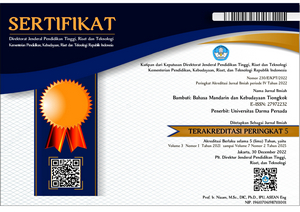Chinese New Year in Siu San Teng Temple, Jambi
PERAYAAN TAHUN BARU IMLEK DI KELENTENG SIU SAN TENG KOTA JAMBI
Abstract
Abstract. The existence of Jambi Chinese cannot be separated from the Siu San Teng temple. Siu San Teng Temple is the oldest temple in Jambi which was built in 1805 under the name Hok Tek temple with the main god Hok Tek Tjeng Sin. Siu San Teng Temple as a place of Tridharma worship. As a place of worship for Tridharma, this temple becomes a place of worship during ce it cap go, namely prayers every 1st and 15th of the Chinese calendar. The Chinese New Year celebration at Siu San Teng temple is marked by the Chinese New Year ceremony itself, namely the installation of Chinese New Year candles, prayers to Tian, the main god Hok Tek Tjengsin, the goddess Kwanyim, and the goddess Zhu Sheng Niang Niang. Apart from praying to these gods, the fangsheng tradition is also carried out as a form of getting rid of bad luck and welcoming the arrival of a better new year. The animal released in this tradition is the sparrow. The Chinese New Year at Siu San Teng Temple is also enlivened by liong and lion dance performances.

This work is licensed under a Lisensi Creative Commons Atribusi 4.0 Internasional.
Authors who publish with this journal agree to the following terms:
- Authors retain copyright and grant the journal right of first publication with the work simultaneously licensed under a Lisensi Creative Commons Atribusi 4.0 Internasional that allows others to share the work with an acknowledgment of the work's authorship and initial publication in this journal.
- Authors are able to enter into separate, additional contractual arrangements for the non-exclusive distribution of the journal's published version of the work (e.g., post it to an institutional repository or publish it in a book), with an acknowledgment of its initial publication in this journal.
- Authors are permitted and encouraged to post their work online (e.g., in institutional repositories or on their website) prior to and during the submission process, as it can lead to productive exchanges, as well as earlier and greater citation of published work (See The Effect of Open Access).









